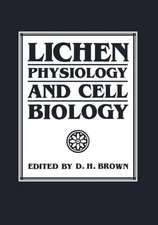Genetic Control of Environmental Pollutants: Basic Life Sciences, cartea 28
Autor Gilbert S. Omenn, Alexander Hollaender, Claire M. Wilsonen Limba Engleză Paperback – 15 apr 2013
Din seria Basic Life Sciences
- 5%
 Preț: 378.07 lei
Preț: 378.07 lei - 15%
 Preț: 647.73 lei
Preț: 647.73 lei - 5%
 Preț: 383.55 lei
Preț: 383.55 lei - 15%
 Preț: 649.06 lei
Preț: 649.06 lei -
 Preț: 401.03 lei
Preț: 401.03 lei - 5%
 Preț: 730.71 lei
Preț: 730.71 lei - 5%
 Preț: 736.92 lei
Preț: 736.92 lei - 5%
 Preț: 726.68 lei
Preț: 726.68 lei - 5%
 Preț: 729.26 lei
Preț: 729.26 lei - 18%
 Preț: 960.61 lei
Preț: 960.61 lei - 5%
 Preț: 375.85 lei
Preț: 375.85 lei - 5%
 Preț: 744.05 lei
Preț: 744.05 lei - 5%
 Preț: 740.58 lei
Preț: 740.58 lei - 5%
 Preț: 733.82 lei
Preț: 733.82 lei - 5%
 Preț: 719.38 lei
Preț: 719.38 lei -
 Preț: 397.59 lei
Preț: 397.59 lei - 5%
 Preț: 390.85 lei
Preț: 390.85 lei - 15%
 Preț: 657.57 lei
Preț: 657.57 lei - 5%
 Preț: 382.99 lei
Preț: 382.99 lei - 5%
 Preț: 400.56 lei
Preț: 400.56 lei - 5%
 Preț: 739.69 lei
Preț: 739.69 lei - 15%
 Preț: 657.25 lei
Preț: 657.25 lei - 18%
 Preț: 959.67 lei
Preț: 959.67 lei - 15%
 Preț: 658.88 lei
Preț: 658.88 lei - 5%
 Preț: 387.39 lei
Preț: 387.39 lei - 5%
 Preț: 376.95 lei
Preț: 376.95 lei - 5%
 Preț: 768.39 lei
Preț: 768.39 lei - 5%
 Preț: 735.83 lei
Preț: 735.83 lei - 15%
 Preț: 651.19 lei
Preț: 651.19 lei - 18%
 Preț: 1228.47 lei
Preț: 1228.47 lei - 15%
 Preț: 595.36 lei
Preț: 595.36 lei - 5%
 Preț: 736.39 lei
Preț: 736.39 lei - 5%
 Preț: 730.55 lei
Preț: 730.55 lei - 18%
 Preț: 960.30 lei
Preț: 960.30 lei - 5%
 Preț: 738.93 lei
Preț: 738.93 lei - 15%
 Preț: 662.16 lei
Preț: 662.16 lei - 15%
 Preț: 663.60 lei
Preț: 663.60 lei -
 Preț: 395.25 lei
Preț: 395.25 lei - 5%
 Preț: 739.13 lei
Preț: 739.13 lei - 15%
 Preț: 639.59 lei
Preț: 639.59 lei - 5%
 Preț: 377.52 lei
Preț: 377.52 lei - 5%
 Preț: 721.40 lei
Preț: 721.40 lei - 18%
 Preț: 1241.10 lei
Preț: 1241.10 lei - 18%
 Preț: 1233.69 lei
Preț: 1233.69 lei
Preț: 401.24 lei
Nou
Puncte Express: 602
Preț estimativ în valută:
76.80€ • 83.45$ • 64.56£
76.80€ • 83.45$ • 64.56£
Carte tipărită la comandă
Livrare economică 21 aprilie-05 mai
Preluare comenzi: 021 569.72.76
Specificații
ISBN-13: 9781468447170
ISBN-10: 1468447173
Pagini: 420
Ilustrații: X, 408 p. 14 illus.
Dimensiuni: 178 x 254 x 22 mm
Greutate: 0.73 kg
Ediția:Softcover reprint of the original 1st ed. 1984
Editura: Springer Us
Colecția Springer
Seria Basic Life Sciences
Locul publicării:New York, NY, United States
ISBN-10: 1468447173
Pagini: 420
Ilustrații: X, 408 p. 14 illus.
Dimensiuni: 178 x 254 x 22 mm
Greutate: 0.73 kg
Ediția:Softcover reprint of the original 1st ed. 1984
Editura: Springer Us
Colecția Springer
Seria Basic Life Sciences
Locul publicării:New York, NY, United States
Public țintă
ResearchCuprins
Welcome and Introduction.- Environmental Toxicants.- Microbial Biodegradation of 2,4,5-Trichlorophenoxyacetic Acid and Chlorophenols.- Bacterial Transformations of and Resistances to Heavy Metals.- The Identification and Cloning of Genes Encoding Haloaromatic Catabolic Enzymes and the Construction of Hybrid Pathways for Substrate Mineralization.- General Discussion: Environmental Toxicants.- Engineering Organisms to Survive.- Engineering Organisms to Survive: Introduction.- Biodegradation in the Estuarine-Marine Environments and the Genetically Altered Microbe.- Plasmid-Mediated Biodegradative Fate of Monohalogenated Biphenyls in Facultatively Anaerobic Sediments.- Land Disposal and Spill Site Environments.- Ecological Constraints on Genetic Engineering.- Panel Discussion: Vulnerability of Ecosystems.- Environmental Waste Streams.- Perspective on Opportunities for Genetic Engineering Applications in Industrial Pollution Control.- Application of Genetic Engineering to Industrial Waste/Wastewater Treatment.- Needs and Strategies for Genetic Control: Municipal Wastes.- Pseudomonas Hydrocarbon Oxidation.- Microbial Enzymes and Lignocellulose Utilization.- Panel Discussion: Comparison of Traditional and Genetic Strategies.- Diverse Capabilities of Microorganisms.- Diverse Capabilities of Microorganisms: Introduction.- Capabilities of Microorganisms (and Microbiologists).- Tools of Genetic Manipulation.- Manipulation of Methanotrophs.- Panel Discussion: Emerging Industrial Applications.- Roundtable Discussion: Directions for the Future.- Posters.- Wastewater Treatment with Bacteria Attached to Fibers.- Dissimilation of Aromatic Compounds by Rhodotorula graminis.- Membrane-Associated Benzoate-4-Hydroxylase from Rhodotorula graminis.- Biodecontamination of a Full-Scale Formaldehyde Spill.- Evolution of New Degradative Functions for Halogenated Aromatics.- Biological Degradation of Polychlorinated Biphenyls by Mutant Organisms.- Gene Engineering of Yeast for the Degradation of Hazardous Wastes.- Molecular Induction by Phenobarbital of Cytochrome P-450 and Epoxide Hydrolase.- Chemistry and Genotoxicity of Runoffs from Model Coal Piles.- Aerobic Microbial Degradation of Glucoisosaccharinic Acid.- Phenol Degradation in Microbial Fixed-Film Bioreactors.- Construction of a “Gene Library” of Pseudomonas sp. B13 and Expression of the 3-Chlorobenzoate Degradative Genes.- Isolation and Characterization of TN-5 Induced Insertion Mutants in the 3-Chlorobenzoate Degradation Pathway of Pseudomonas sp. B13.- Potential Use of Microcosms to Assess Survival, Efficacy, and Environmental Safety of Genetically Engineered Microorganisms.- Closing Remarks.- Participants and Speakers.























